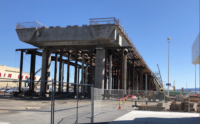Anticipating disruptive mobility technologies, attracting new talent and figuring out how to do public-private partnerships successfully pose key challenges for public transportation agencies. Whatever the challenges, the presence of transit systems is proving beneficial to communities. A new report found that in seven U.S. regions, real estate values increase according to a property’s proximity to transit stations.
The report, “The Real Estate Mantra: Locate Near Public Transportation,” was released by the American Public Transportation Association and the National Association of Realtors at APTA’s annual conference this month in New York City. It found that communities in Boston; Eugene, Ore.; Hartford, Conn.; Los Angeles; Minneapolis-St. Paul; Phoenix; and Seattle located within a half-mile of transit spent up to $4,400 less per household on transportation costs. Median home sale prices increased as much as 24% between 2012 and 2016 for those communities, and office median prices increased as much as 42%.
“There is a growing realization that public transportation serves as a connective tissue,” said Paul Skoutelas, APTA president and CEO. Charlie Oppler, 2019 first vice president of NAR, added that with the growing demand, “the zoning permitting process has to be streamlined. There are so many opportunities for developers to be involved [in transit-oriented development].”
The report also acknowledged the problem of increased property values negatively affecting low- and moderate-income residents. Nuria I. Fernandez, APTA chair and general manager/CEO of the Santa Clara Valley Transportation Authority, notes that her agency adopted an affordable housing policy for trans-oriented development projects stipulating at least 20% affordable units per development. A 7-acre development at Tamien Station in San Jose will exceed that percentage, she adds.
Improving P3s
While there are plenty of potential transit construction opportunities for private investors, the traditional design and construction process is currently discouraging, said APTA panelists. “There is plenty to do in the United States, plenty of needs and opportunities for capital investments,” said Raymond DiPrinzio, executive director with Sumitomo Mitsui Banking Corp. “But projects are not getting to the point where the markets can bid.”
A key problem is that it takes more than 10 years from identifying an infrastructure need to getting the project into predevelopment, noted Laurie Mahon, vice chair of global investment banking for CIBC Capital Markets. “The [identified] need has probably changed dramatically by then,” she said.
John Morton, investment principal with Global Infrastructure Partners, added that the project characteristics may be further distorted by the scrutiny of engineers and accountants. “By the time the project gets to [a private investor], it has been beaten up and run over,” he said.
Moreover, long-term concessionaire contracts can be hindered by owner demands, he said. “If an owner says, ‘I want you to build an airport and operate it for the next 30 or 40 years,’ that’s a problem.” With constant and unpredictable trends, the private builder needs to build for flexibility in order to manage risk over time, he said.
Lack of in-depth knowledge about delivering P3s is a challenge in the U.S., panelists agreed. DiPrinzio noted that not only does Canada’s Infrastructure Ontario provide consistency in the procurement approach, but also “it has 200 people who do nothing else” but P3s. In the U.S., a transportation agency employee “is asked to do another job along with their day job,” he said.
Workforce and Inclusion
Kimberly Slaughter, an APTA board member and transit/rail market sector leader for HNTB Corp., notes that the demand for talent and future leaders is so urgent that APTA’s leadership program will extend its maximum of 25 candidates to 35 in 2020.
Workforce shortages are also affecting engineering firms like HNTB, she adds. “We are all struggling to hire the same people,” she says.
By Aileen Cho in New York City





Post a comment to this article
Report Abusive Comment